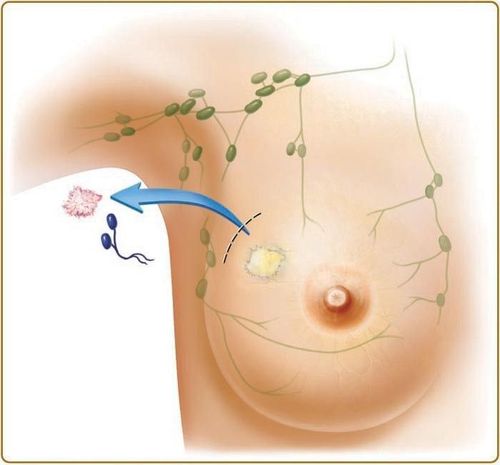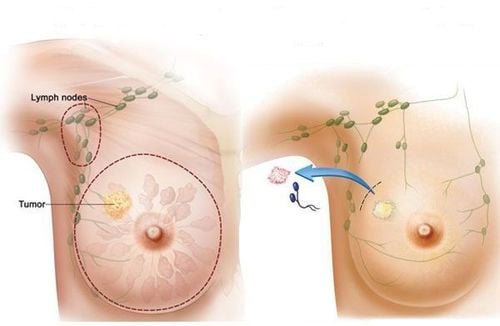This is an automatically translated article.
The article was written by Dr. Oncologist, Vinmec Central Park International General Hospital
Breast-conserving surgery in breast cancer includes many levels: excision of the tumor, partial mastectomy, and quadrant resection of the breast. The surgeon will cut the tumor and surrounding tissue with a safe margin based on the guidance of the ultrasound and mammograms as well as their perception.
1. Learn about Breast Conserving Surgery
Breast-conserving treatment in breast cancer is surgery born in the 1980s by Dr. FISHER, VERONESI. This method has so far been widely applied in advanced countries.
Safe surgical margin is the most important factor of conservative surgery, so it is necessary to remove more healthy tissue around no tumor. Checking for tumor cells or not will be done through cryosurgery right at the time of surgery and sent to the pathologist to read the results immediately. Breast-conserving surgery is often performed along with axillary lymph node dissection.
Depending on the width of the surgery, the breast tissue is removed more or less that we need to put implants or not, or fake bras. Your body will also create scar tissue to fill in the gap, a tissue-differentiated scar that will often be seen on a later mammogram. Scars on the skin in the case of good healing will fade gradually. Your doctor will guide you on how to care for the scar to heal well and most aesthetically.

2. Who can be treated with breast-conserving surgery?
Not all women with breast cancer are suitable for breast-conserving treatment. Breast-conserving treatment is only for women with early-stage breast cancer, the tumor has not spread beyond the mammary gland, and only axillary lymph node metastases. The reason is that surgery can only be performed safely when the tumor is removed and the surrounding normal breast tissue is removed. The breast tissue around the tumor must be checked to make sure that there are no cancer cells left in order to reduce the risk of recurrence. We consider breast-conserving treatment based on the following factors: Age, Nodal status, Tumor histology, Tumor nuclear differentiation, ER status, PR, Ki67, Invasion Lymphatic vascular invasion, comedo histology or not.
Breast-conserving treatment cannot be performed when:
Multifocal cancer Tumor has spread to many parts (quadrants) of the breast Cancer in ducts is diffuse Tumor has spread to the areola, nipple complex ( Because after surgery, it is mandatory to follow up with radiation therapy to reduce the risk of recurrence, conservative surgery is also not performed in women who:
Connective tissue pathology and skin such as scleroderma, because the side effects after radiation will be very serious History of previous radiation therapy to the chest wall due to another disease Disagree with postoperative radiotherapy
3. Possible problems after breast-conserving surgery
After surgery, you will stay in the hospital for about 1-3 days depending on your post-operative recovery, recovery after surgery is faster and gentler than surgery to remove the entire mammary gland. However, you may also experience some situations:
Swelling and bruising at the incision site for a few days Accumulation of fluid around the surgical site, requiring drainage of the incision Incision infection in the mammary gland tissue or lymph node dissection area Axillary Incisional bleeding very rare Some complications from axillary lymph node dissection are associated with axillary lymph node dissection, similar to those seen in axillary mastectomy
4. Breast-conserving surgery or total mastectomy?

When you have an indication for breast-conserving surgery, you may also have the second option of total mastectomy. Sometimes this choice is difficult to decide. Many patients feel that total mastectomy is safer, but many studies in countries with advanced medical background have shown no difference in safety between the two methods. Breast-conserving surgery combined with postoperative radiotherapy has similar safety results as total mastectomy.
5. Advantages and disadvantages of breast-conserving treatment
The most obvious advantage is to ensure aesthetics, patients always feel happier and more satisfied with their body than having to remove the entire breast tissue. They do not have to use breast implants in their daily activities, and their sex life is not affected after treatment. The disadvantage of conservative treatment is that you need to undergo further radiation therapy. Radiation therapy is essential to prevent tumor recurrence and increase survival. However, you need treatment every day for many days, which usually takes about 6-7 weeks, radiation therapy also causes some side effects. If after surgery, the cut edge is not sure that there are no tumor cells, you will have to have another surgery, sometimes you may have to remove the entire breast at the second surgery At Vinmec Central Park Hospital, Faculty of Medicine With a team of highly qualified and experienced surgeons, with the most modern Varian radiotherapy system in Southeast Asia, early breast cancer patients always have a choice. The treatment methods for themselves, especially breast-conserving treatment, bring the best and most aesthetic results.













